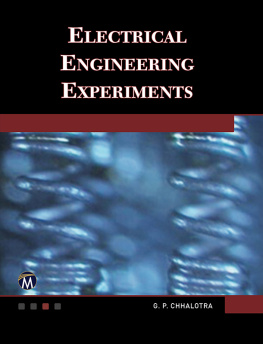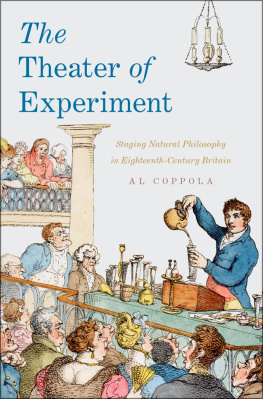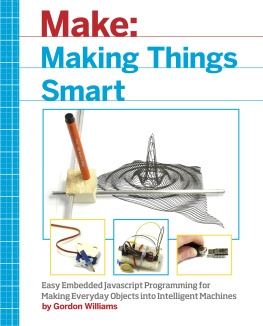ELECTRICAL
ENGINEERING
EXPERIMENTS
LICENSE, DISCLAIMER OF LIABILITY, AND LIMITED WARRANTY
By purchasing or using this book (the Work), you agree that this license grants permission to use the contents contained herein, but does not give you the right of ownership to any of the textual content in the book or ownership to any of the information or products contained in it. This license does not permit uploading of the Work onto the Internet or on a network (of any kind) without the written consent of the Publisher. Duplication or dissemination of any text, code, simulations, images, etc. contained herein is limited to and subject to licensing terms for the respective products, and permission must be obtained from the Publisher or the owner of the content, etc., in order to reproduce or network any portion of the textual material (in any media) that is contained in the Work.
MERCURY LEARNING AND INFORMATION (MLI or the Publisher) and anyone involved in the creation, writing, or production of the companion disc, accompanying algorithms, code, or computer programs (the software), and any accompanying Web site or software of the Work, cannot and do not warrant the performance or results that might be obtained by using the contents of the Work. The author, developers, and the Publisher have used their best efforts to insure the accuracy and functionality of the textual material and/or programs contained in this package; we, however, make no warranty of any kind, express or implied, regarding the performance of these contents or programs. The Work is sold as is without warranty (except for defective materials used in manufacturing the book or due to faulty workmanship).
The author, developers, and the publisher of any accompanying content, and anyone involved in the composition, production, and manufacturing of this work will not be liable for damages of any kind arising out of the use of (or the inability to use) the algorithms, source code, computer programs, or textual material contained in this publication. This includes, but is not limited to, loss of revenue or profit, or other incidental, physical, or consequential damages arising out of the use of this Work.
The sole remedy in the event of a claim of any kind is expressly limited to replacement of the book, and only at the discretion of the Publisher. The use of implied warranty and certain exclusions vary from state to state, and might not apply to the purchaser of this product.
ELECTRICAL
ENGINEERING
EXPERIMENTS
G.P. Chhalotra, PhD

MERCURY LEARNING AND INFORMATION
Dulles, Virginia
Boston, Massachusetts
New Delhi
Copyright 2018 by MERCURY LEARNING AND INFORMATION LLC. All rights reserved.
Original Title and Copyright: Experiments in Electrical Engineering. 2015 by Khanna Publishers.
This publication, portions of it, or any accompanying software may not be reproduced in any way, stored in a retrieval system of any type, or transmitted by any means, media, electronic display or mechanical display, including, but not limited to, photocopy, recording, Internet postings, or scanning, without prior permission in writing from the publisher.
Publisher: David Pallai
MERCURY LEARNING AND INFORMATION
22841 Quicksilver Drive
Dulles, VA 20166
www.merclearning.com
(800) 232-0223
G.P. Chhalotra. Electrical Engineering Experiments.
ISBN: 978-1-683921-14-1
The publisher recognizes and respects all marks used by companies, manufacturers, and developers as a means to distinguish their products. All brand names and product names mentioned in this book are trademarks or service marks of their respective companies. Any omission or misuse (of any kind) of service marks or trademarks, etc. is not an attempt to infringe on the property of others.
Library of Congress Control Number: 2017915453
171819321 This book is printed on acid-free paper in the United States of America.
Our titles are available for adoption, license, or bulk purchase by institutions, corporations, etc. For additional information, please contact the Customer Service Dept. at 800-232-0223 (toll free).
All of our titles are available in digital format at authorcloudware.com and other digital vendors. The sole obligation of MERCURY LEARNING AND INFORMATION to the purchaser is to replace the book, based on defective materials or faulty workmanship, but not based on the operation or functionality of the product.
CONTENTS
EXPERIMENT 1
1.1Object: To Determine Internal Resistance of a Battery
1.2Apparatus
One battery, one ammeter, and one voltmeter.
1.3Experimental Setup
The voltmeter is used to measure the open circuit voltage of the battery and the ammeter is used to measure the short circuit current of the battery, shown in .

Figure 1.1

Figure 1.2
EXPERIMENTAL RESULTS
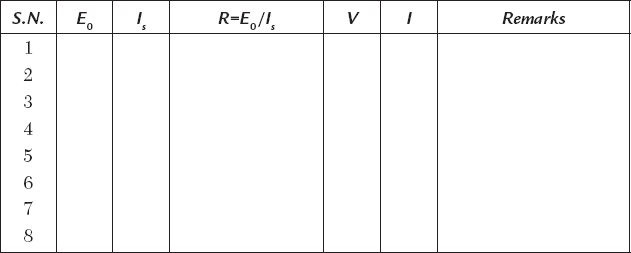
Experimental results are tabulated in the observation table. The internal resistance of the battery is given by:

This is also tabulated in the observation table.
1.4Questions and Answers on the Experiment
The experiment is made to represent a battery by an electrical circuit. The EMF and terminal voltage of the battery can be determined. The EMF of the battery will be constant, but the terminal voltage will fall when the current taken from the battery increases. We call it a load test on the battery.
Q1. How does the EMF differ from the terminal voltage or voltage of the battery?
Ans. The EMF of the battery will always be higher than the voltage. The EMF and voltage differ by a voltage drop in the internal resistance R
| E = V + IRB | (1.2) |
| or |
| EV = IRB | (1.3) |
The VI curve is shown in .
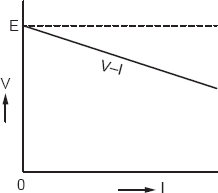
Figure 1.3
Q2. A battery has an EMF of 1.1 volts and an internal resistance of 0.1 ohms. If a resistance of 1 ohm is connected to the terminals, find the current and the terminal voltage. Draw the electrical equivalent circuit of the battery.
Ans.
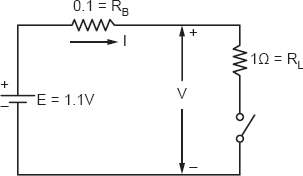
Figure 1.4

| V = IRL = 1 1 = 1 volt | (1.5) |
EXPERIMENT 2
2.1Object: Load Test on a D.C. Series Generator
2.2Experimental Setup
A D.C. series machine is used as a series motor and is rarely used as the generator. If we wish to run the motor as a generator, this experiment will be useful. The series generator is used in traction as a booster, and we cannot disregard this for special purposes.
Next page
